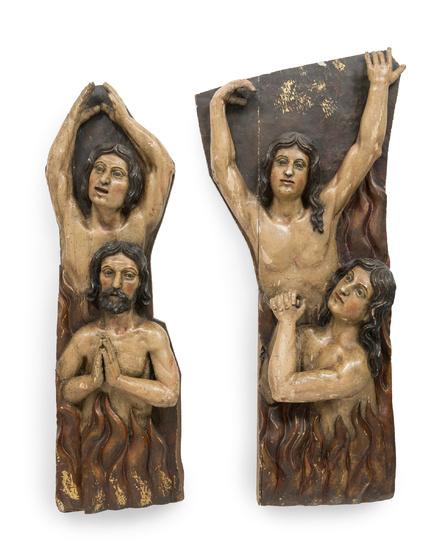Spanish school; 17th century.
Spanish school; 17th century.
"The animas in purgatory".
Carved and polychrome wood.
They present restorations as Repainting, lacking in the carving and damage caused by xylophages.
Measurements: 106 x 44 x 20 cm; 101 x 29 x 16 cm.
The subject and the support of this set indicate that, originally, it was part of a larger sculptural set, probably attached to an architecture, since both carvings are worked in high relief and the back is devoid of any ornamentation. The set of these two reliefs, although varying in size, presents the same concept, the souls burning in flames and begging for forgiveness. It would be an abstraction that tries to symbolize the Purgatory, a representation that reached great popularity during the baroque period. As for the carving, it is worth mentioning the play of volumes that is generated based on planes and the verticality of each of the carvings. In the first place, the waving flames, in second place a figure that joins his hands in an attitude of piety and finally, another figure with his arms raised. It is the artist's own technique that infuses drama to the two pieces, the waves of the flames that grow to the chest of the upper figures, the winding hair of the protagonists, the way in which he captures the gestures individualizing each of the characters, are aesthetic features that reveal the mastery of the author.
Spanish sculpture is one of the most authentic and personal examples of our art, because its conception and form of expression emerged from the people and the deepest feelings that nestled in it. With the economy of the State broken, the nobility in decline and the high clergy burdened with heavy taxes, it was the monasteries, the parishes and the confraternities of clerics and laymen who promoted its development, the works sometimes being financed by popular subscription. Sculpture was thus compelled to embody the prevailing ideals in these environments, which were none other than religious ones, at a time when the counter-reformist doctrine demanded from art a realistic language so that the faithful would understand and identify with what was represented, and an expression endowed with an intense emotional content to increase the fervor and devotion of the people. The religious subject is, therefore, the preferred theme of Spanish sculpture of this period, which in the first decades of the century began with a priority interest in capturing the natural, to progressively intensify throughout the century the expression of expressive values.
COMMENTS
They present restorations as repainting, missing carvings and damage caused by xylophagous.
This lot can be seen at the Setdart Madrid Gallery located at C/Velázquez, 7.
View it on
Estimate
Time, Location
Auction House
Spanish school; 17th century.
"The animas in purgatory".
Carved and polychrome wood.
They present restorations as Repainting, lacking in the carving and damage caused by xylophages.
Measurements: 106 x 44 x 20 cm; 101 x 29 x 16 cm.
The subject and the support of this set indicate that, originally, it was part of a larger sculptural set, probably attached to an architecture, since both carvings are worked in high relief and the back is devoid of any ornamentation. The set of these two reliefs, although varying in size, presents the same concept, the souls burning in flames and begging for forgiveness. It would be an abstraction that tries to symbolize the Purgatory, a representation that reached great popularity during the baroque period. As for the carving, it is worth mentioning the play of volumes that is generated based on planes and the verticality of each of the carvings. In the first place, the waving flames, in second place a figure that joins his hands in an attitude of piety and finally, another figure with his arms raised. It is the artist's own technique that infuses drama to the two pieces, the waves of the flames that grow to the chest of the upper figures, the winding hair of the protagonists, the way in which he captures the gestures individualizing each of the characters, are aesthetic features that reveal the mastery of the author.
Spanish sculpture is one of the most authentic and personal examples of our art, because its conception and form of expression emerged from the people and the deepest feelings that nestled in it. With the economy of the State broken, the nobility in decline and the high clergy burdened with heavy taxes, it was the monasteries, the parishes and the confraternities of clerics and laymen who promoted its development, the works sometimes being financed by popular subscription. Sculpture was thus compelled to embody the prevailing ideals in these environments, which were none other than religious ones, at a time when the counter-reformist doctrine demanded from art a realistic language so that the faithful would understand and identify with what was represented, and an expression endowed with an intense emotional content to increase the fervor and devotion of the people. The religious subject is, therefore, the preferred theme of Spanish sculpture of this period, which in the first decades of the century began with a priority interest in capturing the natural, to progressively intensify throughout the century the expression of expressive values.
COMMENTS
They present restorations as repainting, missing carvings and damage caused by xylophagous.
This lot can be seen at the Setdart Madrid Gallery located at C/Velázquez, 7.



